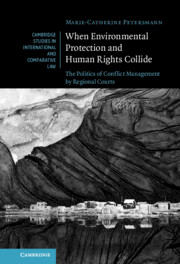 When Environmental Protection and Human Rights Collide
When Environmental Protection and Human Rights Collide Published online by Cambridge University Press: 20 October 2022
This first part explores the origins of the relationship between environmentalism and human rights and traces the evolution of this encounter through a historical lens. It analyses how concerns for environmental protection and human rights emerged as distinct aspirations that progressively evolved towards mutual integration into each other’s normative architecture, legal registers and institutional practices. By examining how the framing of the relationship between ‘Man and Nature’ changed over time and how these changes of perception were legally translated in international instruments, judicial decisions and doctrinal accounts, this part of the book thereby sheds light on a major paradigm shift that occurred in the 1960s, when environmental protection began to be framed as intrinsically intertwined with human rights concerns. This shift corresponds to the first explicit references to human rights in environmental instruments. The analysis unpacks how this radical turn in environmentalism was accommodated at three complementary levels: legislative, adjudicative and doctrinal. This produced a dominant account where environmental protection and human rights are viewed as synergistic and mutually reinforcing objectives, in disregard of the conflicts that also underpin this relation. This account thereby contributes to the literature that critically engages with liberal human rights-based approaches to environmental protection.
To save this book to your Kindle, first ensure [email protected] is added to your Approved Personal Document E-mail List under your Personal Document Settings on the Manage Your Content and Devices page of your Amazon account. Then enter the ‘name’ part of your Kindle email address below. Find out more about saving to your Kindle.
Note you can select to save to either the @free.kindle.com or @kindle.com variations. ‘@free.kindle.com’ emails are free but can only be saved to your device when it is connected to wi-fi. ‘@kindle.com’ emails can be delivered even when you are not connected to wi-fi, but note that service fees apply.
Find out more about the Kindle Personal Document Service.
To save content items to your account, please confirm that you agree to abide by our usage policies. If this is the first time you use this feature, you will be asked to authorise Cambridge Core to connect with your account. Find out more about saving content to Dropbox.
To save content items to your account, please confirm that you agree to abide by our usage policies. If this is the first time you use this feature, you will be asked to authorise Cambridge Core to connect with your account. Find out more about saving content to Google Drive.